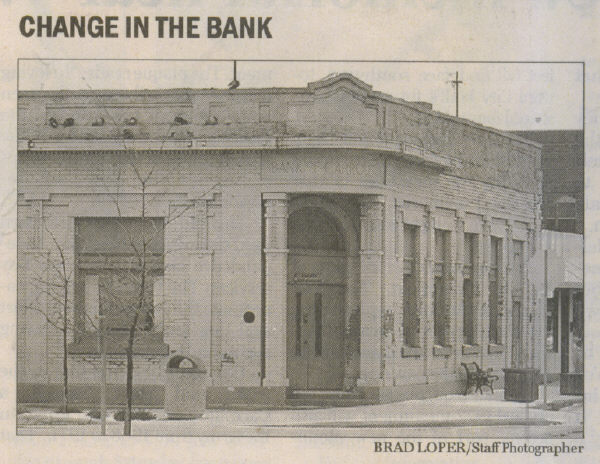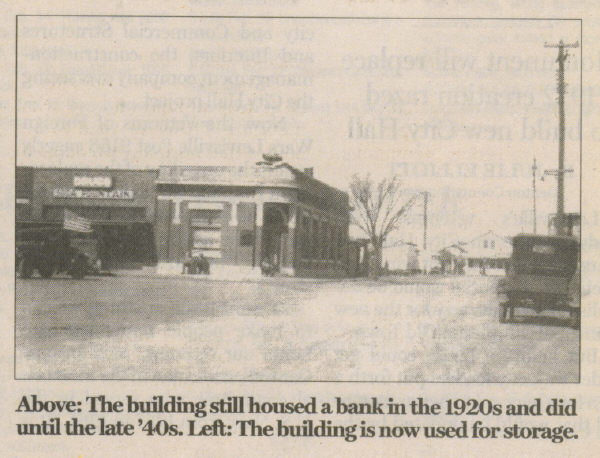|
Bank's looks belie its vibrant past
Some hope that a little work will put the bustle back in
the building
by Scott Stafford
It survived the great Carrollton flood of 1908 and the devastating fire
of 1916. It also stood through the 1929 stock market crash and nearly 40
years of vacancy and neglect. But now the historic Carrollton Bank building
could be lost to deterioration or redevelopment.
Built in 1907, the old Carrollton Bank building is currently used for
storage and remains the last significant piece of Old Downtown Carrollton
that has not been refurbished.
The words "Bank of Carrollton" are etched in concrete over the door, which
faces the corner of Broadway and Main. Some of the windows have been boarded
or painted over.
The paint applied about 25 years ago during the bank's brief life as a
church is peeling off the brick. Many local merchants and residents want the
building to reclaim its stature in the revived commercial zone.
"Obviously the building is in need of some fairly significant restoration,"
said David Gwin, neighborhood partnership manager for Carrollton. "As an
architecturally significant building on a prominent corner, it could be very
productive."
Some see the bank as a potential centerpiece in a district that has
struggled back to commercial viability after years of storefront vacancies,
disrepair and abandonment by retail customers dating back to the 1970s.
"Its very important to this neighborhood," said Mary Lou Powell, owner of
Mary Lou's Gifts and Collectables. "That building is part of our history.
And it has such great possibilities."
Today, the bank houses supplies and tools for Shaker Wood works, the shop
next door. Dennis Furlow has been selling, his custom-made furniture and
antiques at the shop since 1995. He started renting the bank space for
storage about two years later.
In order to use the building, which has no heat or air conditioning, he has
had to do some repairs to the plumbing, wiring, roof, window frames and
exterior concrete. The building still has roof leaks and water and termite
damage, Mr. Furlow said.
|

|
|
-
1903: Opened in the southwest, corner of the
square
-
1907: Bank built a new building in the
northeast corner of the square
-
1908: Survived the 1908 flood with minor
damage and became the First Bank of Carrollton
-
1916: Survived the fire of 1916
-
1929: Stock market crash
-
Late 1940s; Bank left; White's Auto Store
opened
-
1954: White's Auto Store closed
-
1976: Carrollton Pentecostal Church opened
-
1980: Church moved out
-
1995: present: Became storage for Shaker
Woodworks
|
|
 |
According to Old Downtown developer Dave Oldfield, a number of people have
inquired about purchasing or leasing the building, but the owner, Jack
Vandergriff, has declined to sell or lease it and has not invested any
money in improvements or repairs.
"I tried to buy that building, and I couldn't get it," said Mr. Oldfield. "I
talked to Jack over the years, and I said, "Jack, I'll be glad to lease it
from you, or I'll buy it from you, because it's a very important part of
downtown." Well, he wouldn't move off dead center for anything or anybody."
The Dallas Central Central Appraisal District lists the property and
building as being worth $75,600.
Owner won't budge
Mr. Vandergriff, 90, was unwilling to discuss his reluctance to sell or
refurbish the structure. "I don't want to sell it. This is a free country,
and it's not for sale."
"As long as the building is not a threat to public safety, or doesn't
violate a city code, then the owner is within his right to maintain the
property as he sees fit," said Mr. Gwin.
After the bank left the building in the late 1940's, it remained dormant for
a short time until White's Auto Store moved in.
In 1954, according to business owner Jess Woody of Carrollton, the auto
parts store moved to a bigger location on the east side of the square, and
the bank again remained dormant. A variety of businesses moved in and out of
the building until 1976, when the Carrollton Pentecostal Church opened. It
moved out in 1980.
Many in Carrollton consider the bank a historical landmark for the city and
the square. According to Georgia Ogle's
Elm Fork Settlement,
a history of the area, J.C. Davis opened the bank in 1903 as the Bank of
Carrollton at the southwestern corner of the square.
He built and opened the new bank building, where it stands today, at the
northeast corner of the square in 1907.
After the 1908 flood, which caused minor damage to the structure, the name
changed to First State Bank of Carrollton, according to Ms. Ogle's account.
The bank changed hands and names several times over they years until it
moved out in the late 1940s.
Steps to historical status
Chris Barton, Carrollton's chief planner, said that in order for the bank
to be recognized by the city as a historical building, the building's owner,
the Historic Preservation Advisory Committee or a group of residents must
propose historical recognition to the City Council. The council would then
have to approve the designation.
"But I'm not sure how realistic that is," said Mr. Barton. "Would our City
Council go over the objections of property owners to restrict them? Probably
not. Carrollton just doesn't work that way.
"But I just hate to sit here and watch it deteriorate year after year," said
Mr. Barton, Echoing the sentiments of many Old Downtown merchants and
Carrollton residents.
Although the building is in Old Downtown Carrollton, no local ordinance
protects structures in that district, said Mr. Barton. "Right now that
building is in jeopardy because there is nothing really to prevent the
landowner from coming in and applying for, say, a demolition permit and
tearing it down. People would get upset, but it would still be gone.
Restoration Trend
A number of Texas towns, including Denton and Pilot Point, have
designated turn-of-the-century bank building as historical, said Kim
McKnight, program specialist for the Texas Historic Commission.
"In a lot of towns it's not uncommon to have a really nice corner bank
building - they're so prized and so beloved; that's why they're actually
some of the nicest buildings on these squares," said Ms. McKnight.
"And a lot of really neat things have been done with some of these bank
buildings all over the state."
Mr. Furlow is happy to use the space for his work and hopes it remains
available to home. "I hope he doesn't sell it. I like being here," he said.
Notes:
|
![]() Carrollton-Farmers
Branch TXGenWeb
Carrollton-Farmers
Branch TXGenWeb
